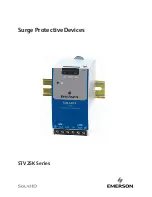
fault occur. This is an unlikely event, because
other fault sensing relaying tends to clear faults
faster, even if primary protection fails.
Fig. 26 shows the 46 relay connection. CTs on
either side of the generator can be used, since
the relay protects for events external to the
generator. The Basler BE1-46N alarm unit will
alert the operator to the existence of a dangerous
condition.
FIGURE 26. NEGATIVE-SEQUENCE CURRENT RELAY
(46) PROTECTS AGAINST ROTOR OVERHEATING
DUE TO A SERIES UNBALANCE OR PROTRACTED
EXTERNAL FAULT. NEGATIVE SEQUENCE VOLTAGE
RELAY (47) (LESS COMMONLY APPLIED) ALSO
RESPONDS.
Negative sequence voltage (47) protection, while
not as commonly used, is an available means to
sense system imbalance as well as, in some
situations, a misconnection of the generator to a
system to which it is being paralleled.
Out of Step Protection
When a generator pulls out of synchronism with
the system, current will rise relatively slowly
compared to the instantaneous change in current
associated with a fault. The out-of-step relay
uses impedance techniques to sense this
condition. The relay will see an apparent load
impedance swing as impedance moves from
Zone 1 to Zone 2 (Fig. 27). The time it takes for
the load impedance to traverse from Zone 1 to
Zone 2 is used to decide if an out of step
FIGURE 27. OUT OF STEP RELAYING (78)
condition is occurring. A moving impedance is
identified as a swing rather than a fault, so
appropriate fault detection relaying may be
blocked.
Selective Tripping and Sequential Tripping
It is a practice at some generators to selectively
trip the prime mover, the field, and the generator
breaker, depending on the type of fault that is
detected. For instance, if the generator is
protected by a 51V and an 87G, and only the
51V trips, it may be assumed that the fault is
external to the generator and, hence, the 51V
only trips the generator breaker and rapidly pulls
back the excitation governor and prime mover
set points. However, if there is no 87G, the 51V
trips the entire unit. Associated with this concept
is sequential tripping used for orderly shutdown.
To prevent overspeeding a generator during
shutdown, it is sometimes the practice first to
trip the prime mover and trip the main breaker
and field only after a reverse power relay verifies
the prime mover has stopped providing torque to
the generator.
Synchronism Check and Auto Synchronizing
Before connecting a generator to the power
system, it is important that the generator and
system frequency, voltage magnitude, and
phase angle be in alignment, referred to as
synchronism checking (25). Typical parameters
are shown in Fig. 28. Typical applications call for
no more than 6RPM error, 2% voltage magnitude
difference, and no more than 10° phase angle
error before closing the breaker. The Basler
BE1-951, BE1-GPS, and BE1-25 all can perform
the sync check function.
Auto synchronizing (25A) refers to a system to
automatically bring a generator into synchronism
with the power system. It involves sending
voltage and speed raise and lower commands to
the voltage regulator and prime mover governor.
When the system is in synchronism, the
autosync relay is sometimes designed to send a
close command in advance of the zero phase
angle error point to compensate for breaker close
delays. The 25 relay, which usually is set to
supervise the 25A and manual sync function,
usually is set less tight than the 25A so as to
coordinate with the actions of the 25A.
15
Содержание BE1-1051
Страница 1: ...GeneratorProtection ApplicationGuide...












































